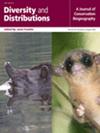Unveiling the Hidden Impact: Urbanisation Disproportionately Reduces Belowground Insect Functional Group Richness
Abstract
Aim
Anthropogenic effects, for example, urbanisation, induce environmental stressors that often result in biodiversity loss, with significant implications for ecosystem services. In particular, the decline in insect biodiversity can reduce essential services such as pest suppression or food web disruption in urban areas. Potentially, the impact of urbanisation may differ between above- and belowground insect communities. This is because the two groups may be influenced by different abiotic and biotic factors. However, this remains unclear to date.
Location
Korea.
Methods
We investigated the consequences of landscape changes and urbanisation factors, for example, increased temperature, impervious surfaces, building density, and changes in vegetation cover, on the diversity and functional group of aboveground and belowground insects. We used sweeping methods to sample aboveground insects, while belowground insects were collected using the sifting method and Berlese funnel. We also collected environmental and insect diversity data from urban areas with varying population densities and analysed the correlational patterns between the degree of urbanisation and insect richness and abundance.
Results
Despite varying urbanisation levels, overall insect species richness and abundance remained relatively stable across the studied landscapes. Aboveground insects showed no relationship with urbanisation, while belowground communities exhibited declining species richness and abundance. Notably, belowground generalist and specialist species richness showed opposite patterns. Belowground predator insect species richness and abundance suffered most from urbanisation, while aboveground herbivorous insect abundance increased.
Main Conclusion
This study highlights the disproportionate impact of urbanisation on belowground insect communities compared to aboveground communities. These findings can inform the development of targeted conservation strategies that safeguard insect diversity during urban planning initiatives, promoting healthy and resilient urban ecosystems.


 求助内容:
求助内容: 应助结果提醒方式:
应助结果提醒方式:


